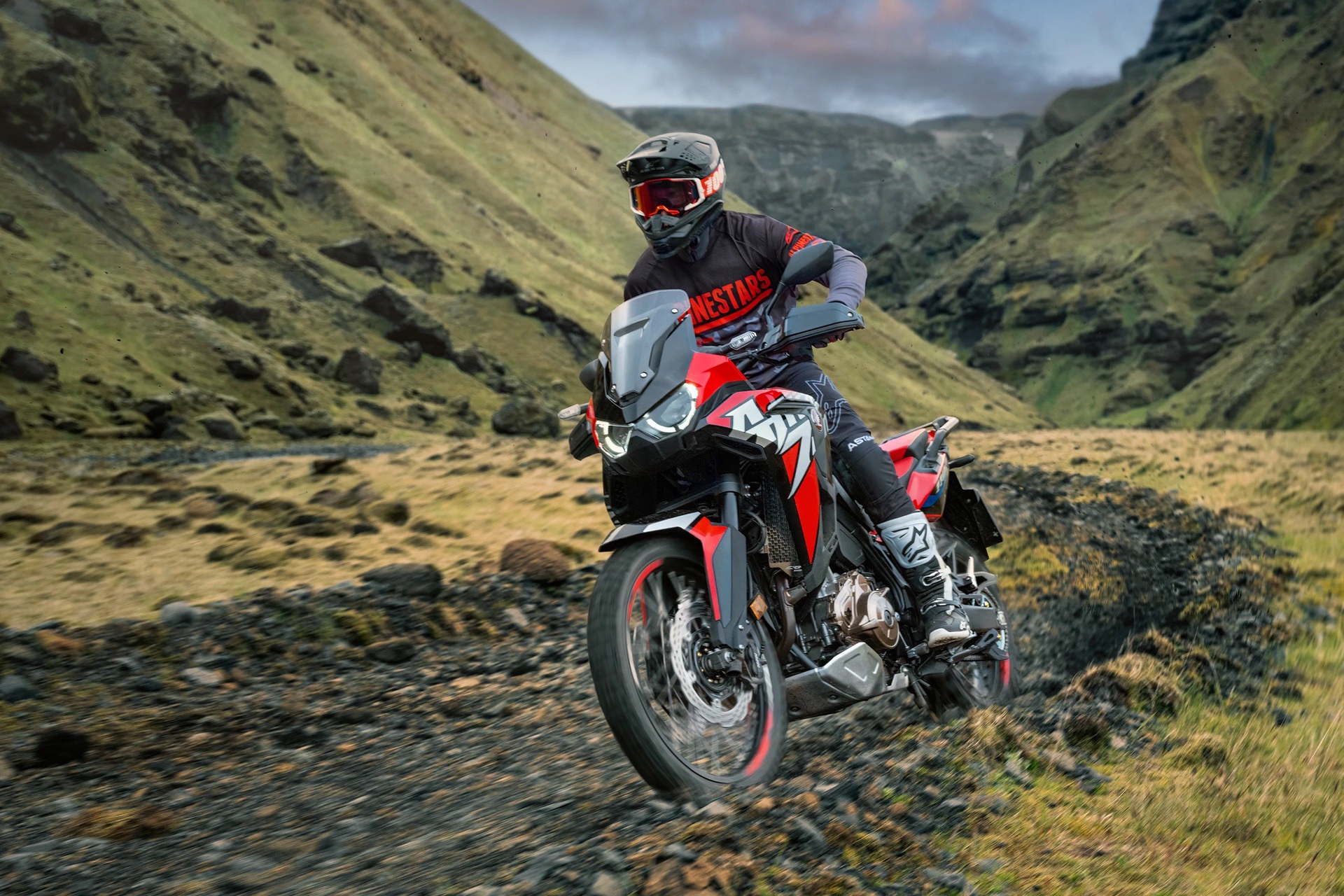In the world of motorcycles, it seems that drivetrains really don’t get the credit they deserve. Much of the talk around a bike focuses on the engine—if it’s an inline-four or a v-twin, a triple or a parallel-twin—and how much power it puts out. The engine is also the source of that thing we all love about our bikes, the noise and the responsiveness to even the smallest movement of the wrist.
See Also: The Best V-Twin Motorcycles for Beginner Riders
However, without a drivetrain, that twist of the wrist would produce nothing but noise. It is the chain, the belt, or the shaft drive that actually transmits the physical forces created from miniature explosions (or in the modern day, electrical current) to the rear wheel, sending us down the road with grins hidden under our helmets. From a certain point of view, the drivetrain is indeed the most important part of your bike.
For a beginner rider, there are advantages and disadvantages to all three types, and it is not our intention in this article to go into exceptional detail about the hows and whys of each. Instead, we are going to give a top-down view of each drivetrain, including what it brings to the table for a beginner rider, and give the basic pros and cons so when it comes time to buy your first, second, or even third bike, you will have an idea of what you are looking for.
The Traditional: Chain Drives & Why They Are the Most Popular Drive Type
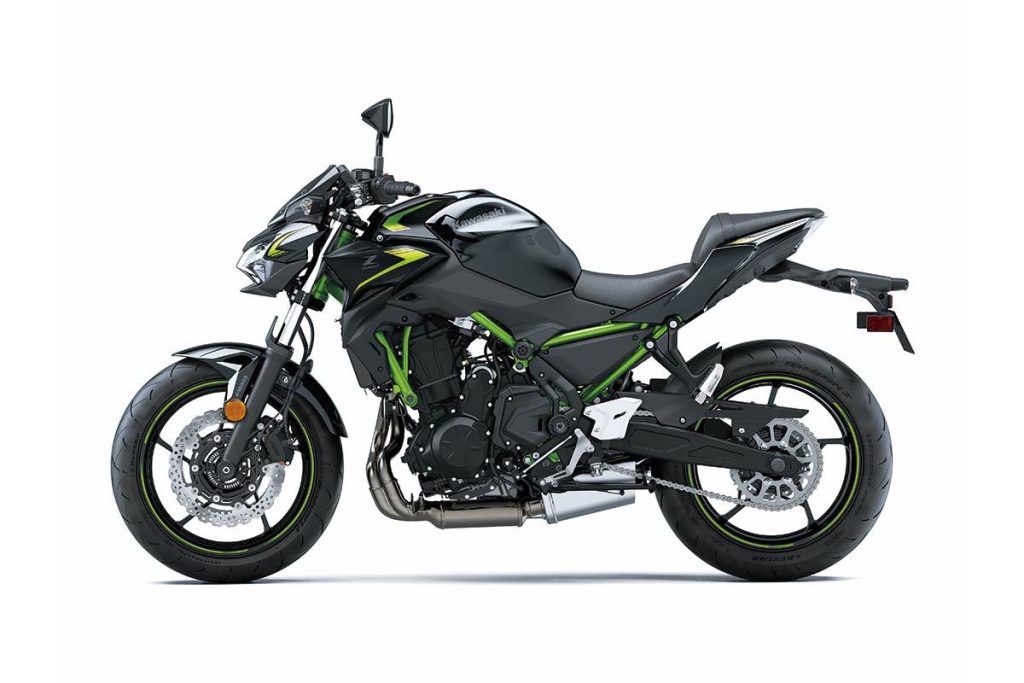
Although the statistics are constantly shifting because of new bikes coming to market and older models getting discontinued, anywhere from 80% to 90% of new motorcycles that are sold today use chains as their drivetrain.
This stems from a multitude of reasons—the least of which is that the original motorized bicycles, the direct precursors to full-on motorcycles, used a chain, way back at the end of the 19th century. In fact, “pin and roller chains,” to use the official name for the style of chain our bikes use, date back as far as the 16th century (and some sketches from one Leonardo Da Vinci).
Chain Drive Pros
While traditional, the modern chains of the 21st century are implemented for one reason above absolutely all else: manufacturing cost. Chains are, if you were to analyze them in the most literal sense, a series of sealed bearings linked together via inner and outer plates, held together by riveted pins.
Common metals like iron, chromium, molybdenum, and the like are also prevalent, both in raw ore form and in recycled metals. This means they are relatively cheap to source and combine into strong alloys, which are then turned into the links of the chain. While we, as consumers, might pay anywhere between $60 to $300 for a chain, rest assured that the markup on that chain is keeping a lot of people employed and businesses profitable. Such is capitalism!
That linked series is then passed over two sprockets with a defined ratio of teeth to fit in the gaps between the rollers. That ratio is usually in the realm of 1:3 or 1:4, so if your front sprocket, applying the torque and power of the engine to the chain, had 10 teeth, your rear sprocket would have 30 (1:3) or 40 (1:4) teeth.
As we stated at the start, that is a very simplified look at how a chain drive works. How many links on the chain, how many teeth per sprocket, even the distance between the sprockets all affect how much power is applied to the rear axle, and hence the rear wheel and tire.
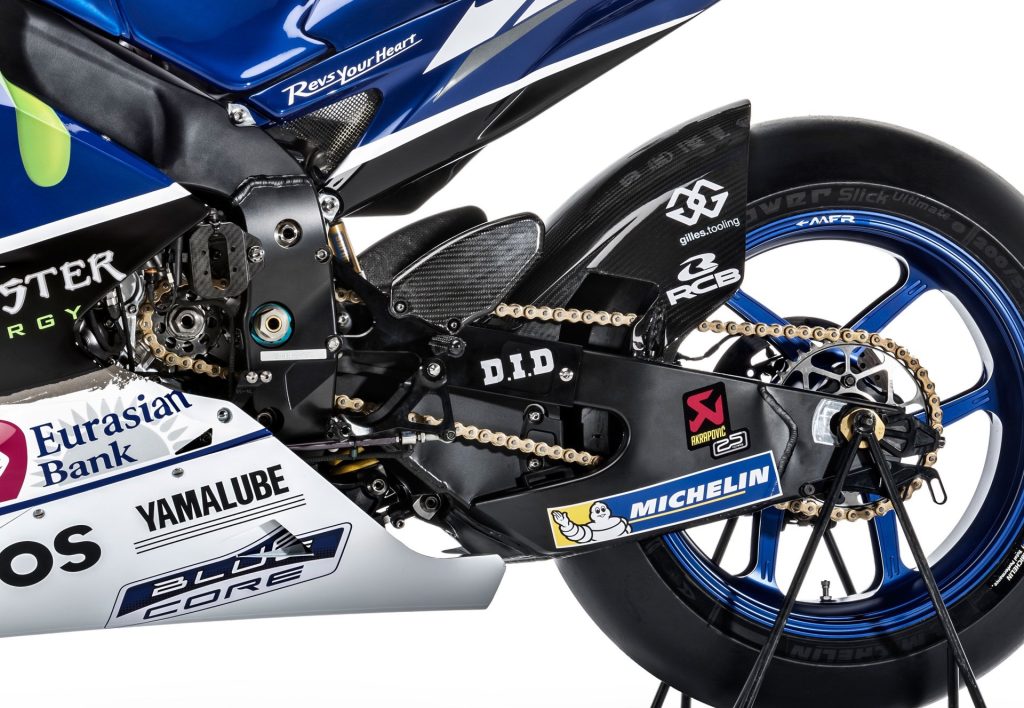
The biggest benefits of a chain drive is that, surprising as it may sound, they suffer the least parasitic loss of transmitted power. Stated a different way, a chain-drive motorcycle is akin to a front-wheel-drive car, where the only mechanical interfaces needed to put power to the road are the transmission and the two short drive axles attached to the front wheels.
Chain Drive Cons
While chains are sounding pretty damned good right now, there is one major con and one minor con to them as well. They are the drive type that needs the most frequent replacement, as over time, the pins inside the collars, as well as the rubber seals, will start to wear down and cause the chain to “stretch.” While the metal itself isn’t elastic, it’s inside the sealed part where the pin has started to wear down from rubbing against the collar, allowing a minute amount of movement. Across a hundred links or more, that can lead to ½ to 1 inch of slack, which can be quite dangerous. Without getting into unpleasantly descriptive detail, there is an extremely good reason why every bike has a chain guard across the top of the chain from the front to the rear sprocket.
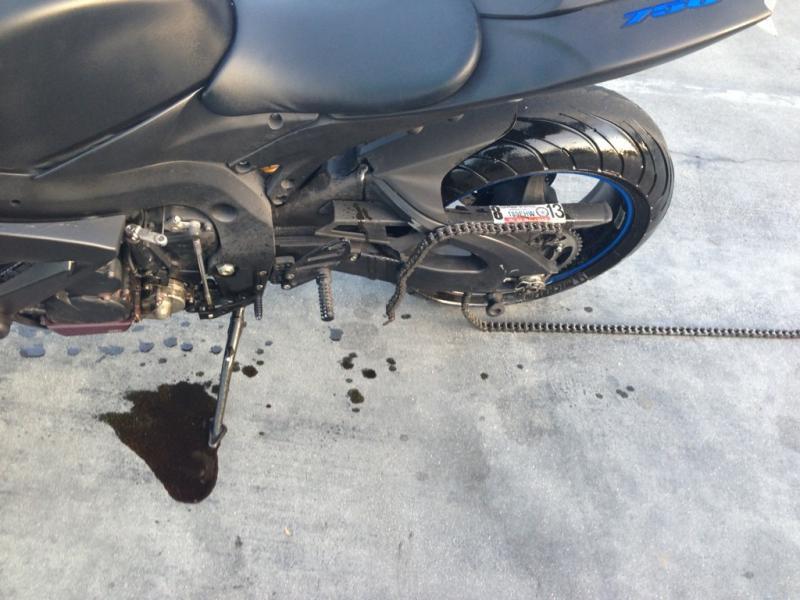
The other con (though not as major) of a chain is that they are the most maintenance-heavy compared to belt or shaft drives. For many riders, this almost becomes a pro, giving them an excuse to go out to the garage to do some stuff on their bikes, but your mileage may vary.
Chains require a good cleaning every 400 to 800 miles. You’ll also have to apply chain lube, test the chain tension, inspect the sprockets, and adjust them if necessary. All of that takes at most 30 minutes (if that, once you’ve done it a few times).
Make sure to use a good chain lube and take your time the first few times you clean and lube the chain. Soon enough, you might even start a weekend ritual, especially if you use your bike to commute during the week.
The Badass: Belt Drives & Why They Are Typically on Cruisers
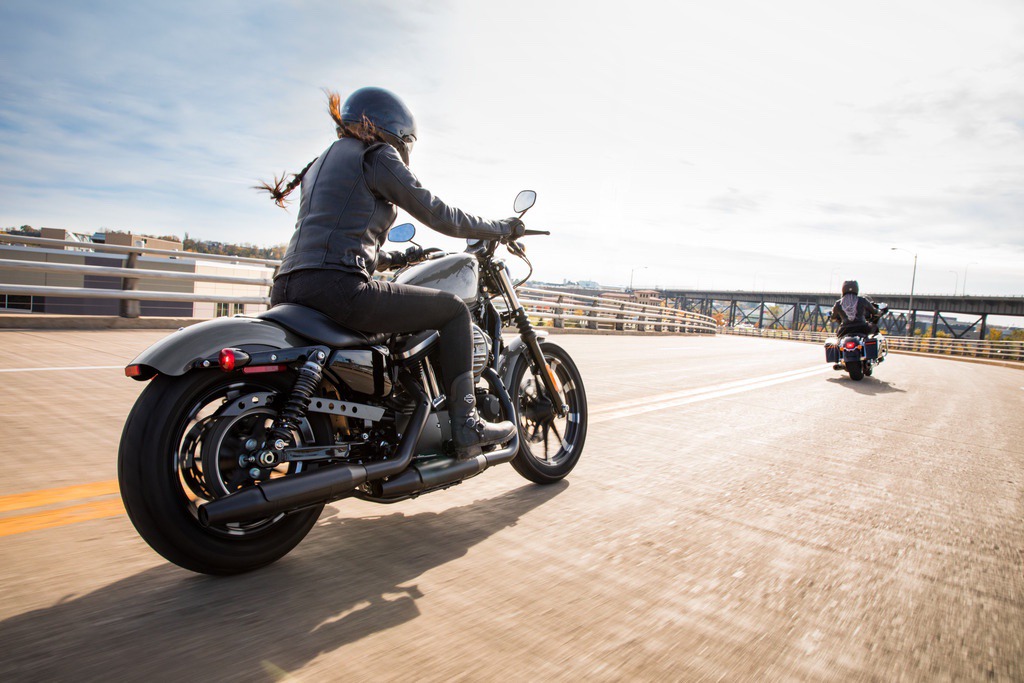
Belts in drivetrains are not all that new, having been used as far back as the first few prototypes of a motorized bicycle, and were commonly used in steam-powered cars at the end of the 19th century. The actual technology of the belts, however, has advanced in leaps and bounds from the original friction-based canvas and leather belts, to full rubber-and-steel-combination belts used today.
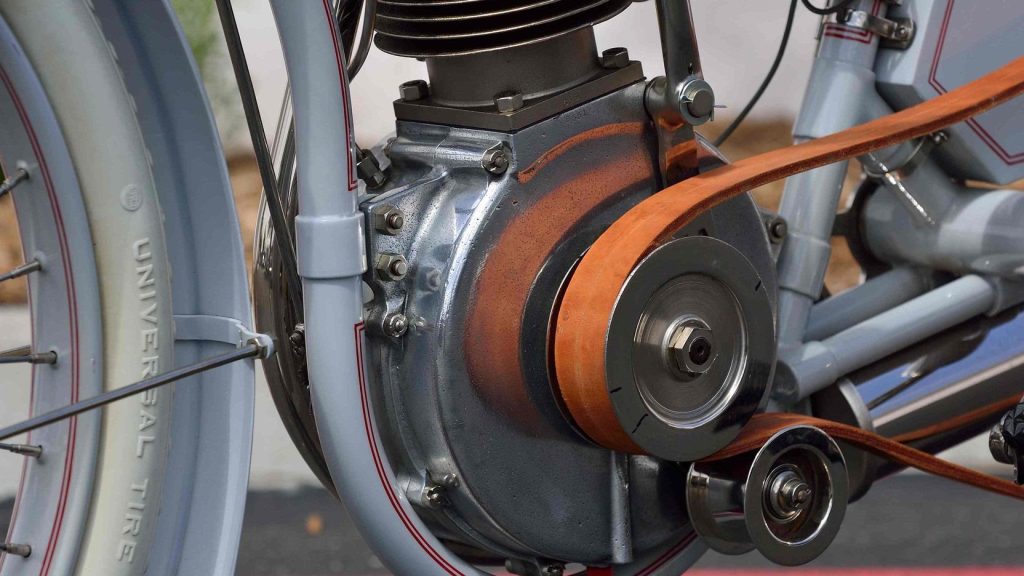
Belt Drive Pros
One of the major pros about a belt drive is that it is not restricted to being a certain width. As long as your power and rear sprockets are of the same width, you can technically put as wide a belt as you want on a motorcycle. In most applications, however, the widest a belt will go is between 1 to 2 inches, with some coming in as thin as ½ inch. It is in the chopper, aftermarket modding, and motorcycle drag racing communities that you will find wider belts.
The physics behind the width of the belt is why you’ll also find them mostly on V-twin cruisers that are not full continental cruisers or interstate bikes (see also: the Kawasaki Vulcan 900 in our list of The Best Touring Motorcycles for New Riders). Since the biggest driving point of most cruisers is their torque figures, a 1 inch wide belt has more surface area to transmit that power from the drive sprocket to the rear sprocket, if you consider even the biggest of sportbike chains to be about ½ inch wide.
The counterpoint is that because of the extra surface area, there is a bit more parasitic loss of power during the transfer—but as long as the belt is at the proper tension and the bike is in good repair, it is quite difficult to feel the extra loss.
Another major pro to belts is that, if you invest in a good one and take care of all the common maintenance, they last a hell of a lot longer than a chain. To wit, a very well maintained chain will last anywhere from 5,000 to 10,000 miles, and if you don’t keep an eye on tension and follow a proper cleaning schedule, you might be on the shallower end of that range.
Belts, on the other hand, can last anywhere from 20,000 to 30,000 miles if kept in good condition. As well, since the only lubrication needed with a belt drive is at the transmission and at the rear axle grease points for the metal bits there, a belt drive is also much, much cleaner.
Belt Drive Cons
On the flipside, one of the biggest cons about a belt drive is the entire fact that they are not all that common. Because there is a less demand for supply, that translates into belts being more expensive to replace, as with chains, when you replace a belt, you will more than likely be replacing the sprockets as well.
Consider that a full 1 ½ inch belt and sprocket kit for, say, a Harley-Davidson Sportster will run you close to $1,000, compared to a chain and sprocket kit for a Ducati Diavel (the closest they have to a sport cruiser) running you only about $400.
Image Via: <a href=”https://motorbikewriter.com/wp-content/uploads/2018/10/Buell-belt-drive.jpg”>MotorbikeWriter</a>
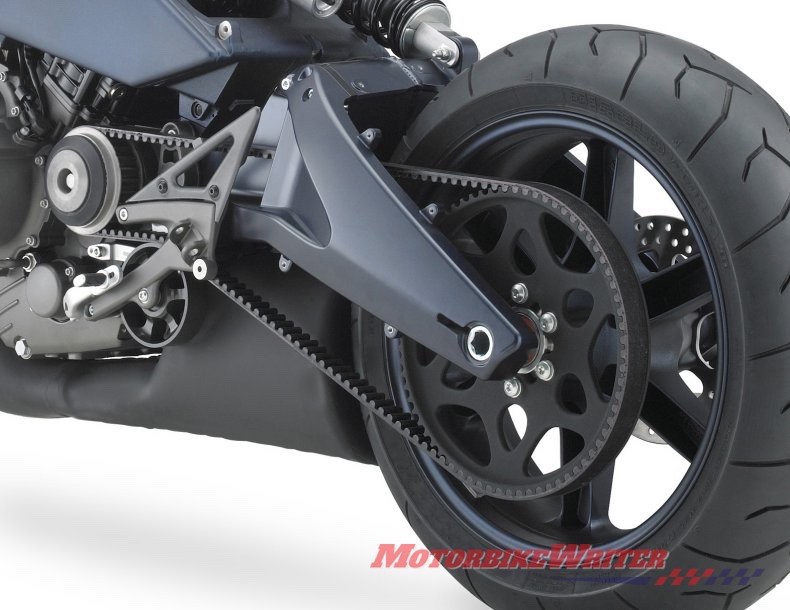
The other major con about belts is that they are, oddly, more sensitive to tension than chains. Without correct tension, the belt can move side to side in the drive and/or rear sprockets, and start to wear down the sides of the belt against the sprockets.
It is because of this sensitivity to tension that you will find belts very prevalent on hard-tail bikes and bobbers. And if you do have a belt on a bike with rear suspension, you will more often than not find a spring-loaded pulley wheel right after the drive sprocket. When the belt loosens as the rear suspension compresses, this wheel will push against the belt to keep it at the correct tension.
The Elegant: Shaft Drives & Why They Are Becoming More Common
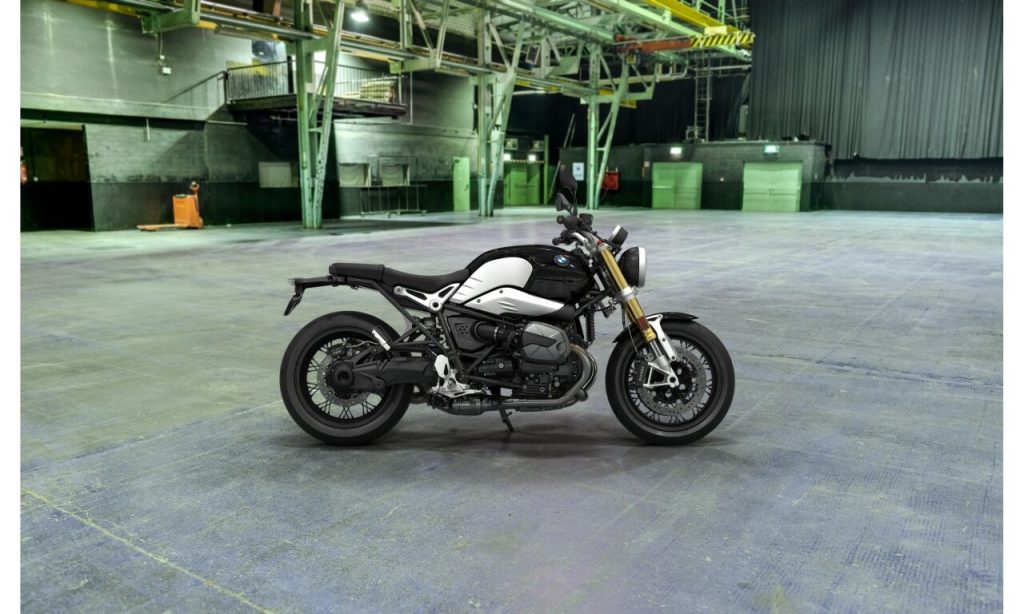
At last we come to the currently least common drive type: the shaft drive. To answer the question we can already sense on the tip of your tongues, the reason that shaft drives are far less common is down to two major cons about them. So, instead of listing the pros first, here are those two cons: the price and the weight.
Shaft Drive Cons
In terms of price, because you have an actual spinning driveshaft being fed off of the transmission and into a 90 degree gear at the rear hub, it is not as simple as two sprockets and a chain or belt linking them. Much like a front engine, rear wheel drive car, there are gear ratios to consider at the transmission end, and a “differential” at the rear hub to handle translating the drive power to axle power to turn the wheel.
If this sounds complex, it is because it is by far the most complex of the three drive types. Furthermore, in the most basic of terms, complexity equals higher cost.
It should also be noted here that there are some bikes with an exposed shaft instead of a sealed one, but they are very few and far between, The only one that is currently on the market that we (currently) know about being the BMW R18.
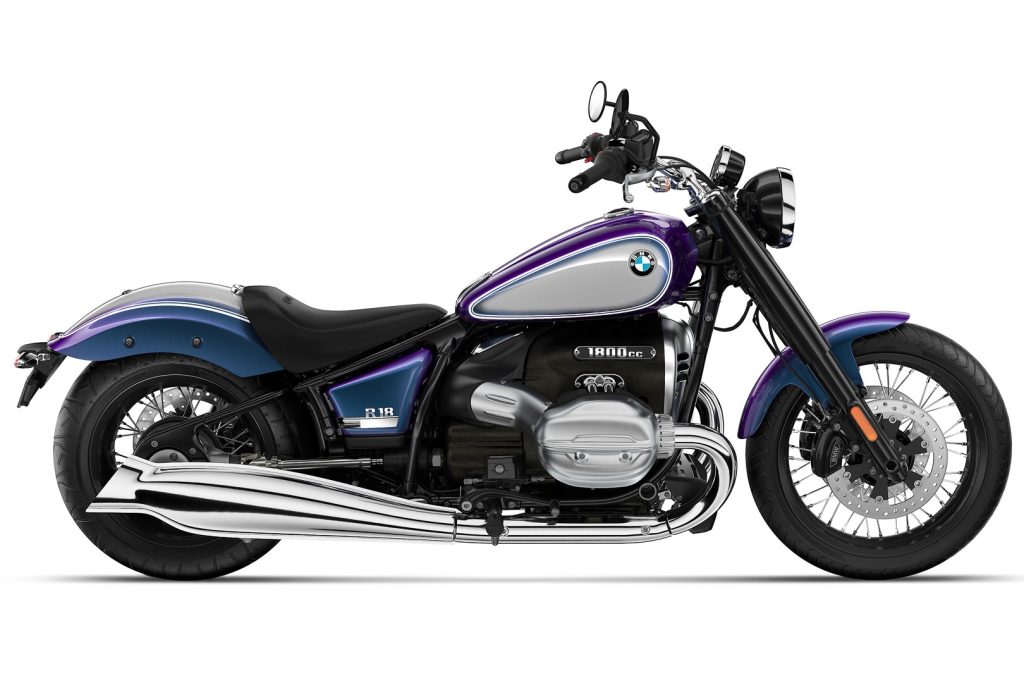
In terms of weight, consider that you have a driveshaft of solid metal inside a sleeve that is also solid metal that is usually built into the swingarm in some manner, and sealed gear linkages at each end that hold lubricant. When compared to a chain or a belt, a shaft weighs easily five times as much as both other types combined—if not more. For this reason, the most common places you find shaft drives are on more luxury-oriented motorcycles.
Shaft Drive Pros
With those two major cons out of the way, the biggest pro about a shaft drive is that it is extremely, and we mean extremely, reliable. Keep the lubricant oil topped up for the shaft and the rear hub assembly, change your transmission and engine oil regularly, and a shaft drive will just keep spinning away without issue.
While you have to change a chain every 10,000 miles or so, and a belt every 20,000 to 30,000, you will never need to change a shaft drive out unless something goes catastrophically wrong. It can easily last as long as the bike does.
Another of the major pros about a shaft drive (and why they are slowly becoming more common), is they are also extremely clean. Being a shaft sealed inside of a metal sleeve means that dirt, grime, sand, and water have no way of touching the actual shaft itself, meaning it won’t grind down or rust due to being ridden in adverse conditions.
Because of that, and as well as the luxury/premium status of a shaft drive, the two types of bikes that use them the most are continental tourers such as the Honda Goldwing, and ADV bikes that are prone to see more off-road use than on-road, like BMW’s GS-series of bikes.
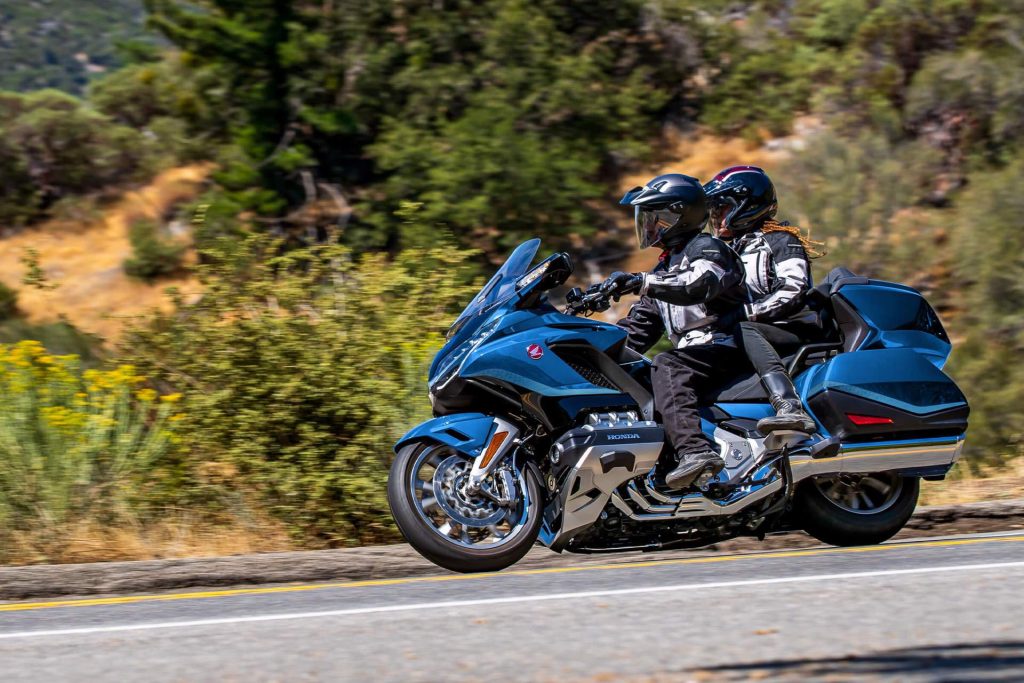
Many other styles of motorcycles are starting to adopt the shaft drive. You can now find shaft drives on power cruisers like the Triumph Rocket III, neo-retro runabouts like Moto Guzzi’s V7 models, and even on sport touring bikes such as BMW’s new R1250RS motorcycle. The only place you won’t find them is on dedicated sport bikes and supersports, as in those applications, the extra weight upsets the balance towards the rear of the bike.
Which Is the Best Type of Drive Train For You?
As a beginner rider, almost every motorcycle that is in the category of “first bike” will have a chain drive. This is not to say that you are forced to use a chain, it is more along the lines that bikes that are made to be new rider friendly are often looking at being less expensive than “intermediate” bikes.
The above also helps to reinforce proper maintenance and care for your two wheeled fun machine, so that when you do graduate up to a second or even third bike, you’ll have that innate, built in sense to check the bike before each ride and take care of any small maintenance items when they arise.
That said, there are some bikes out there that may not be labeled as purely beginner bikes, but can be used as such with appropriate caution and care to not get in over your head. These include the Harley-Davidson Iron 883 and Sportster S, which do have belt drives, even in their lowest spec.
The Iron 883, in particular, is passed around as an entry-level sports cruiser for those that want a bit of American Iron under them—but it still has a crapton of torque down low because of the V-twin, so be gentle with that right wrist.
If we had to put words to paper and seal it with a stamp, the best drive type for a new rider would be a chain. Inexpensive, lightweight, already on 85% of new bikes as is, and replacements and servicing are widely available. Proper maintenance is something that needs to be reinforced from day one, as unlike a car, if something goes wrong on a bike, there is no secondary backup, especially if your chain snaps and cuts your rear tire. Clean, lube, maintain, check tension, and look after it properly, and you’ll be able to get a good couple of seasons out of each chain if you’re riding every day.
Shaft drives have been, and still are, more of a “luxury” item on higher-end models, although Triumph and BMW are working to bring it more into the mainstream level of bikes. You’ll still be paying for it, however, as even the R1250RS sport touring bike starts at over $16,000, and most Triumphs with shafts also start around there and higher.
These bikes are very lovely to have, and even on something like a BMW R Nine T, the power delivery and feel is exceptional, but if you really want one on your bike, respect the fact that a) they are usually fitted to bikes with bigger and stronger engines and b) the power transfer really is immediate, so you need, absolutely need, to have the idiot filter between your brain and your right wrist. If you have one in place, and can afford a shaft drive bike, then enjoy!

